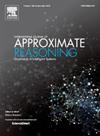LEVEL OF AWARENESS AMONG STUDENTS IN TAIF UNIVERSITY TOWARD KERATOCONUS, TAIF, SAUDI ARABIA
IF 3.2
3区 计算机科学
Q2 COMPUTER SCIENCE, ARTIFICIAL INTELLIGENCE
引用次数: 0
Abstract
Objectives: To determine the level of awareness of keratoconus (KC)among students at Taif University in Taif, Saudi Arabia. Subjects and Methods: A cross-sectional study was done on 957 students from Taif university, KSAfrom March to August 2021. An online-based survey was done using a pr-designed questionnaire that included items on socio-demographic data, having KC, and awareness about KC. Results: 33.8% of students heard about KC, 12.7% heard about it from social media, and 29.5% reported that KC is a thin protruded cornea. Almost half 53.6% reported that KC might lead to myopia, 24.6% is related to allergy, 33.9% thought it is hereditary and the majority 49.2% did not know its treatment. The prevalence of poor, fair, and good knowledge regarding KC was 48.9%, 38.1%, and 13% respectively. Femalessignificantlyknewthe relationship between KC and myopia, allergy, and heredity, did not know KC treatment and had good knowledge aboutKCcompared to males. Non-medical students had a significanthigher percent of those who knew that KC is a thin protruded cornea but did not know KC treatment. Conclusion : This study revealed insufficient knowledge regarding KC among studied students. This is a need to increase awareness about KC through health awareness programs and community campaigns for better eye health.塔伊夫大学学生对沙特阿拉伯塔伊夫圆锥角膜的认知程度
目的:了解沙特塔伊夫大学学生对圆锥角膜(KC)的认知水平。研究对象和方法:本研究于2021年3月至8月对泰国塔伊夫大学957名学生进行了横断面研究。一项基于网络的调查使用了预先设计的问卷,包括社会人口统计数据,是否有KC以及对KC的认识。结果:33.8%的学生听说过KC, 12.7%的学生从社交媒体上听说过KC, 29.5%的学生报告KC是一种薄薄的突出的角膜。近一半(53.6%)的人认为KC可能导致近视,24.6%的人认为与过敏有关,33.9%的人认为是遗传性的,49.2%的人不知道如何治疗。关于KC的不良知识、公平知识和良好知识的患病率分别为48.9%、38.1%和13%。与男性相比,女性对KC与近视、过敏和遗传的关系了解显著,对KC的治疗不了解,对KC的认识较好。知道KC是一种薄而突出的角膜,但不知道KC治疗方法的非医学生的比例明显更高。结论:本研究显示学生对KC的认知不足。有必要通过健康意识项目和社区运动来提高对KC的认识,以改善眼睛健康。
本文章由计算机程序翻译,如有差异,请以英文原文为准。
求助全文
约1分钟内获得全文
求助全文
来源期刊

International Journal of Approximate Reasoning
工程技术-计算机:人工智能
CiteScore
6.90
自引率
12.80%
发文量
170
审稿时长
67 days
期刊介绍:
The International Journal of Approximate Reasoning is intended to serve as a forum for the treatment of imprecision and uncertainty in Artificial and Computational Intelligence, covering both the foundations of uncertainty theories, and the design of intelligent systems for scientific and engineering applications. It publishes high-quality research papers describing theoretical developments or innovative applications, as well as review articles on topics of general interest.
Relevant topics include, but are not limited to, probabilistic reasoning and Bayesian networks, imprecise probabilities, random sets, belief functions (Dempster-Shafer theory), possibility theory, fuzzy sets, rough sets, decision theory, non-additive measures and integrals, qualitative reasoning about uncertainty, comparative probability orderings, game-theoretic probability, default reasoning, nonstandard logics, argumentation systems, inconsistency tolerant reasoning, elicitation techniques, philosophical foundations and psychological models of uncertain reasoning.
Domains of application for uncertain reasoning systems include risk analysis and assessment, information retrieval and database design, information fusion, machine learning, data and web mining, computer vision, image and signal processing, intelligent data analysis, statistics, multi-agent systems, etc.
 求助内容:
求助内容: 应助结果提醒方式:
应助结果提醒方式:


